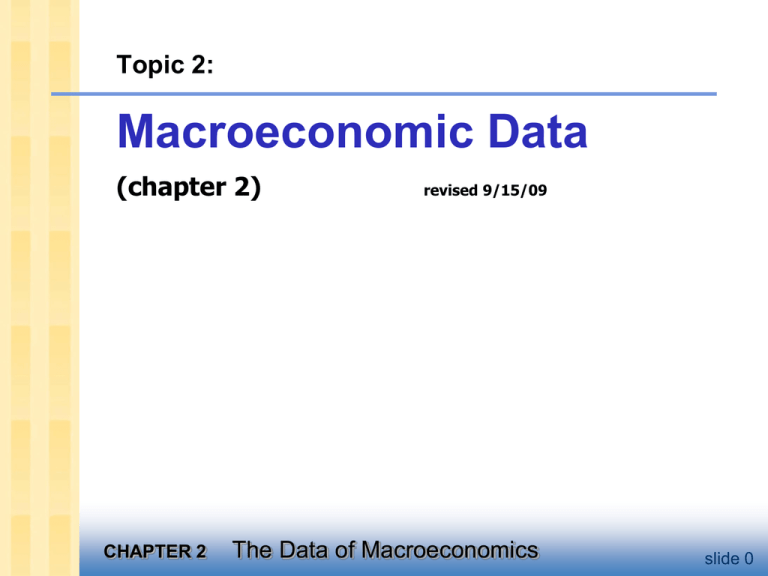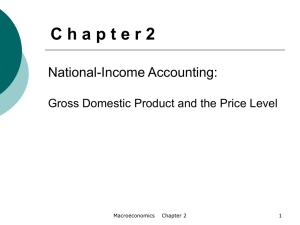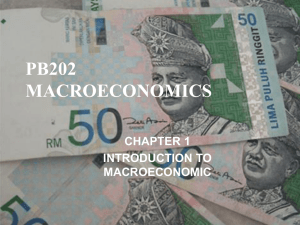Mankiw 5/e Chapter 2: The Data of Macroeconomics
advertisement

Topic 2: Macroeconomic Data (chapter 2) CHAPTER 2 revised 9/15/09 The Data of Macroeconomics slide 0 Learning objectives In this chapter, you will learn about how we define and measure: Gross Domestic Product (GDP) the Consumer Price Index (CPI) the Unemployment Rate CHAPTER 2 The Data of Macroeconomics slide 1 Gross Domestic Product Two definitions: 1. Total expenditure on domestically-produced final goods and services 2. Total income earned by domestically-located factors of production CHAPTER 2 The Data of Macroeconomics slide 2 Why expenditure = income In every transaction, the buyer’s expenditure becomes the seller’s income. Thus, the sum of all expenditure equals the sum of all income. CHAPTER 2 The Data of Macroeconomics slide 3 The Circular Flow Income($) Labor House holds Firms Goods(bread) Expenditure ($) CHAPTER 2 The Data of Macroeconomics slide 4 Consumption (C) def: the value of all goods • durable goods last a long time and services bought by ex: cars, home households. Includes: appliances • non-durable goods last a short time ex: food, clothing • services work done for consumers ex: dry cleaning, air travel. CHAPTER 2 The Data of Macroeconomics slide 5 U.S. Consumption, 2001 $ billions Consumption Durables $7,064.5 % of GDP 69.2% 858.3 8.4 Nondurables 2,055.1 20.1 Services 4,151.1 40.7 CHAPTER 2 The Data of Macroeconomics slide 6 Investment (I) def1: spending on [the factor of production] capital. def2: spending on goods bought for future use. Includes: business fixed investment spending on plant and equipment that firms will use to produce other goods & services residential fixed investment spending on housing units by consumers and landlords inventory investment the change in the value of all firms’ inventories CHAPTER 2 The Data of Macroeconomics slide 7 U.S. Investment, 2001 $ billions Investment Business fixed $1,633.9 % of GDP 16.0% 1,246.0 12.2 Residential fixed 446.3 4.4 Inventory -58.4 -0.6 CHAPTER 2 The Data of Macroeconomics slide 8 Investment vs. Capital Capital is one of the factors of production. At any given moment, the economy has a certain overall stock of capital. Investment is spending on new capital. CHAPTER 2 The Data of Macroeconomics slide 9 Investment vs. Capital Example (assumes no depreciation): 1/1/2002: economy has $500b worth of capital during 2002: investment = $37b 1/1/2003: economy will have $537b worth of capital CHAPTER 2 The Data of Macroeconomics slide 10 Stocks vs. Flows Flow Stock More examples: stock flow a person’s wealth a person’s saving # of people with college degrees # of new college graduates the govt. debt the govt. budget deficit CHAPTER 2 The Data of Macroeconomics slide 11 Government spending (G) G includes all government spending on goods and services. G excludes transfer payments (e.g. unemployment insurance payments), because they do not represent spending on goods and services. CHAPTER 2 The Data of Macroeconomics slide 12 Government spending, 2001 $ billions Gov spending Federal $1,839.5 % of GDP 18.0% 615.7 6.0 Non-defense 216.6 2.1 Defense 399.0 3.9 1,223.8 12.0 State & local CHAPTER 2 The Data of Macroeconomics slide 13 Net exports (NX = EX - IM) def: the value of total exports (EX) minus the value of total imports (IM) U.S. Net Exports, 1960-2000 50 0 -50 $ billions -100 -150 -200 -250 -300 -350 -400 1960 1965 CHAPTER 2 1970 1975 1980 1985 1990 The Data of Macroeconomics 1995 2000 slide 14 An important identity Y = C + I + G + NX where Y = GDP = the value of total output C + I + G + NX = aggregate expenditure CHAPTER 2 The Data of Macroeconomics slide 15 A question for you: Suppose a firm produces $10 million worth of final goods but only sells $9 million worth. Does this violate the expenditure = output identity? CHAPTER 2 The Data of Macroeconomics slide 16 Why output = expenditure Unsold output goes into inventory, and is counted as “inventory investment”… …whether the inventory buildup was intentional or not. In effect, we are assuming that firms purchase their unsold output. CHAPTER 2 The Data of Macroeconomics slide 17 GDP: An important and versatile concept We have now seen that GDP measures total income total output total expenditure the sum of value-added at all stages in the production of final goods CHAPTER 2 The Data of Macroeconomics slide 18 GNP vs. GDP Gross National Product (GNP): total income earned by the nation’s factors of production, regardless of where located Gross Domestic Product (GDP): total income earned by domestically-located factors of production, regardless of nationality. (GNP – GDP) = (factor payments from abroad) – (factor payments to abroad) CHAPTER 2 The Data of Macroeconomics slide 19 Discussion Question: What explains why GNP differs from GDP for some of the following countries? CHAPTER 2 The Data of Macroeconomics slide 20 (GNP – GDP) as a percentage of GDP for selected countries, 1997. U.S.A. Bangladesh Brazil Canada Chile Ireland Kuwait Mexico Saudi Arabia Singapore CHAPTER 2 0.1% 3.3 -2.0 -3.2 -8.8 -16.2 20.8 -3.2 3.3 4.2 The Data of Macroeconomics slide 21 Real vs. Nominal GDP GDP is the value of all final goods and services produced. Nominal GDP measures these values using current prices. Real GDP measure these values using the prices of a base year. CHAPTER 2 The Data of Macroeconomics slide 22 Real GDP controls for inflation Changes in nominal GDP can be due to: changes in prices changes in quantities of output produced Changes in real GDP can only be due to changes in quantities, because real GDP is constructed using constant base-year prices. CHAPTER 2 The Data of Macroeconomics slide 23 Practice problem 2002 2003 P Q P Q good A $1 10 $2 15 good B $10 3 $15 4 Compute nominal GDP in 2002 and 2003 Compute real GDP in each year using 2002 as the base year. CHAPTER 2 The Data of Macroeconomics slide 24 Answers to practice problem Nominal GDP multiply Ps & Qs from same year 2002: $1 x 10 + $10 x 3 = 2003: $2 x 15 + $15 x 4 = Real GDP $40 $90 multiply each year’s Qs by 2002 Ps 2002: as above: 2003: $1 x 15 + $10 x 4 = $40 $55 (2002$) So in real terms, GDP did not rise as much as it would seem from nominal terms. CHAPTER 2 The Data of Macroeconomics slide 25 (billions of U.S. dollars) U.S. Real & Nominal GDP, 11,000 10,000 9,000 8,000 7,000 6,000 5,000 4,000 3,000 2,000 1,000 0 1965 1970 1975 1980 NGDP (billions of $) CHAPTER 2 1985 1967-2001 1990 1995 2000 RGDP (billions of 1996 $) The Data of Macroeconomics slide 26 GDP Deflator The inflation rate is the percentage increase in the overall level of prices. One measure of the price level is the GDP Deflator, defined as Nominal GDP GDP deflator = 100 Real GDP CHAPTER 2 The Data of Macroeconomics slide 27 Understanding the GDP deflator Example with 3 goods For good i = 1, 2, 3 Pit = the market price of good i in month t Qit = the quantity of good i produced in month t NGDPt = Nominal GDP in month t RGDPt = Real GDP in month t CHAPTER 2 The Data of Macroeconomics slide 28 Understanding the GDP deflator NGDPt P1t Q1t P2t Q2t P3t Q3t GDP deflator 100 100 RGDPt RGDPt Q1t 100 RGDPt Q2t Q3t P1t P2t P3t RGDPt RGDPt The GDP deflator is a weighted average of prices. The weight on each price reflects that good’s relative importance in GDP. Note that the weights change over time. CHAPTER 2 The Data of Macroeconomics slide 29 Working with percentage changes USEFUL TRICK #1 For any variables X and Y, the percentage change in (X Y ) the percentage change in X + the percentage change in Y EX: If your hourly wage rises 5% and you work 7% more hours, then your wage income rises approximately 12%. CHAPTER 2 The Data of Macroeconomics slide 30 Working with percentage changes USEFUL TRICK #2 the percentage change in (X/Y ) the percentage change in X the percentage change in Y EX: GDP deflator = 100 NGDP/RGDP. If NGDP rises 9% and RGDP rises 4%, then the inflation rate is approximately 5%. CHAPTER 2 The Data of Macroeconomics slide 31 Consumer Price Index (CPI) A measure of the overall level of prices Published by the Bureau of Labor Statistics (BLS) Used to – track changes in the typical household’s cost of living – adjust many contracts for inflation (i.e. “COLAs”) – allow comparisons of dollar figures from different years CHAPTER 2 The Data of Macroeconomics slide 32 How the BLS constructs the CPI 1. Survey consumers to determine composition of the typical consumer’s “basket” of goods. 2. Every month, collect data on prices of all items in the basket; compute cost of basket 3. CPI in any month equals Cost of basket in that month 100 Cost of basket in base period CHAPTER 2 The Data of Macroeconomics slide 33 The composition of the CPI’s “basket” Food and bev. 17.6% Housing 5.8% 5.9% 2.8% Apparel 2.5% Transportation 4.5% 4.8% Medical care Recreation 16.2% Education Communication 40.0% Other goods and services CHAPTER 2 The Data of Macroeconomics slide 34 Understanding the CPI Example with 3 goods For good i = 1, 2, 3 Ci = the amount of good i in the CPI’s basket Pit = the price of good i in month t Et = the cost of the CPI basket in month t Eb = cost of the basket in the base period CHAPTER 2 The Data of Macroeconomics slide 35 Understanding the CPI Et P1t C1 + P2t C2 + P3t C3 CPI in month t 100 100 Eb Eb C1 C2 C3 100 P1t P2t P3t Eb Eb Eb The CPI is a weighted average of prices. The weight on each price reflects that good’s relative importance in the CPI’s basket. Note that the weights remain fixed over time. CHAPTER 2 The Data of Macroeconomics slide 36 Reasons why the CPI may overstate inflation Substitution bias: The CPI uses fixed weights, so it cannot reflect consumers’ ability to substitute toward goods whose relative prices have fallen. Introduction of new goods: The introduction of new goods makes consumers better off and, in effect, increases the real value of the dollar. But it does not reduce the CPI, because the CPI uses fixed weights. Unmeasured changes in quality: Quality improvements increase the value of the dollar, but are often not fully measured. CHAPTER 2 The Data of Macroeconomics slide 37 The CPI’s bias The Boskin Panel’s “best estimate”: The CPI overstates the true increase in the cost of living by 1.1% per year. Result: the BLS has refined the way it calculates the CPI to reduce the bias. It is now believed that the CPI’s bias is slightly less than 1% per year. CHAPTER 2 The Data of Macroeconomics slide 38 CPI vs. GDP deflator prices of capital goods • included in GDP deflator (if produced domestically) • excluded from CPI prices of imported consumer goods • included in CPI • excluded from GDP deflator the basket of goods • CPI: fixed • GDP deflator: changes every year CHAPTER 2 The Data of Macroeconomics slide 39 Two measures of inflation Percentage change 16 CPI 14 12 10 8 6 GDP deflator 4 2 0 -2 1948 1953 1958 1963 1968 1973 1978 1983 1988 1993 1998 Year CHAPTER 2 The Data of Macroeconomics slide 40 Measuring Unemployment: Categories of the population employed working at a paid job unemployed not employed but looking for a job labor force the amount of labor available for producing goods and services; all employed plus unemployed persons not in the labor force not employed, not looking for work. CHAPTER 2 The Data of Macroeconomics slide 41 Two important labor force concepts unemployment rate percentage of the labor force that is unemployed labor force participation rate the fraction of the adult population that ‘participates’ in the labor force CHAPTER 2 The Data of Macroeconomics slide 42 Compute percentage changes in labor force statistics Suppose the population increases by 1% the labor force increases by 3% the number of unemployed persons increases by 2% Compute the percentage changes in the labor force participation rate: 2% the unemployment rate: 1% CHAPTER 2 The Data of Macroeconomics slide 43 Okun’s Law (Observation) Employed workers help produce GDP, while unemployed workers do not. So one would expect a negative relationship between unemployment and real GDP. This relationship is clear in the data… CHAPTER 2 The Data of Macroeconomics slide 44 Okun’s Law Okun’s Law states that a one-percent decrease in unemployment is associated with two percentage points of additional growth in real GDP Percentage change 10 in real GDP 8 6 1951 1984 2000 4 1999 1993 2 1975 0 -2 -3 1982 -2 -1 0 1 2 3 4 Change in unemployment rate CHAPTER 2 The Data of Macroeconomics slide 45 Chapter Summary 1. Gross Domestic Product (GDP) measures both total income and total expenditure on the economy’s output of goods & services. 2. Nominal GDP values output at current prices; real GDP values output at constant prices. Changes in output affect both measures, but changes in prices only affect nominal GDP. 3. GDP is the sum of consumption, investment, government purchases, and net exports. CHAPTER 2 The Data of Macroeconomics slide 46 Chapter Summary 4. The overall level of prices can be measured by either the Consumer Price Index (CPI), the price of a fixed basket of goods purchased by the typical consumer the GDP deflator, the ratio of nominal to real GDP 5. The unemployment rate is the fraction of the labor force that is not employed. When unemployment rises, the growth rate of real GDP falls. CHAPTER 2 The Data of Macroeconomics slide 47 CHAPTER 2 The Data of Macroeconomics slide 48









